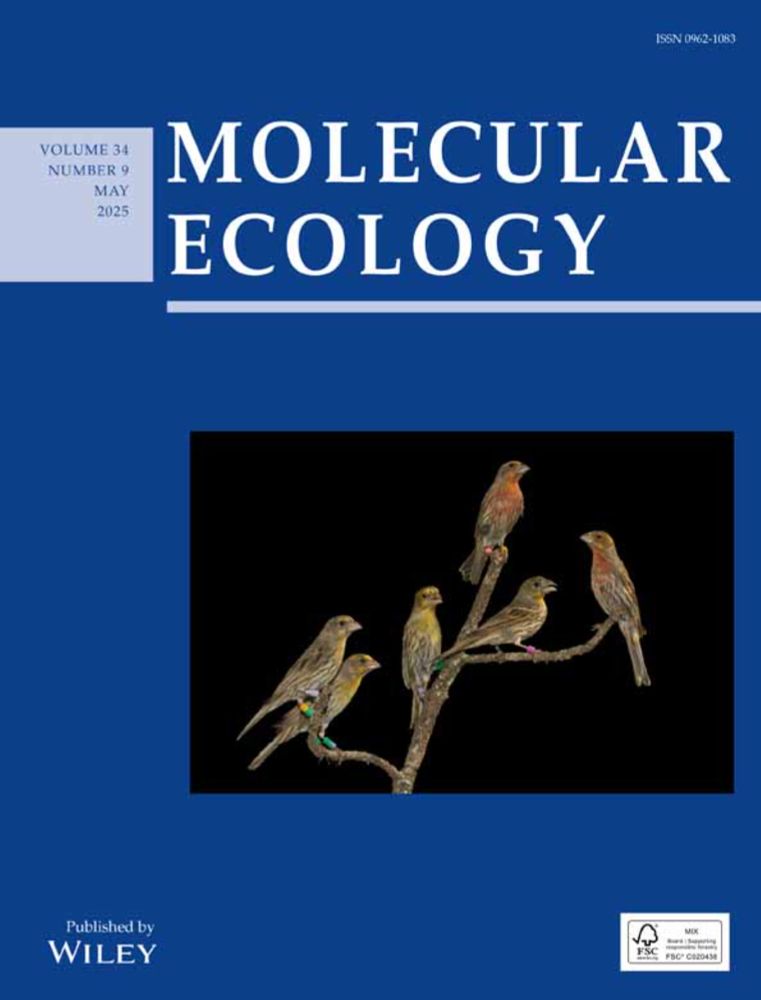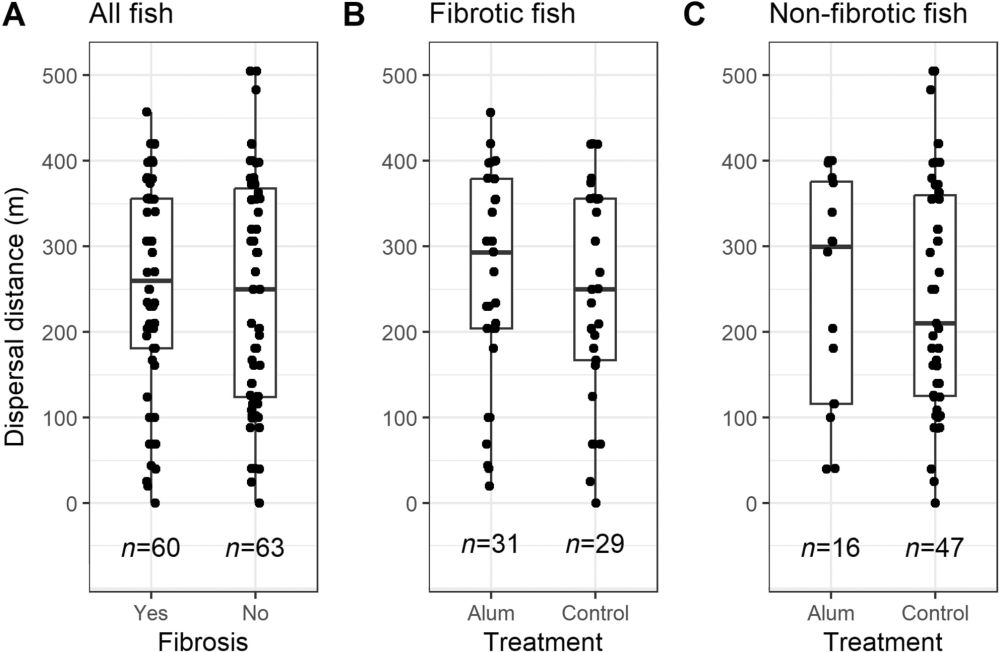Meta-analysis reveals the tempo of evolutionary parallelism of local adaptation between native and introduced ranges of plant species https://www.biorxiv.org/content/10.1101/2025.09.04.674372v1
10.09.2025 04:32 — 👍 0 🔁 1 💬 0 📌 0
Just created a stickleback feed so it’s easy to see what other Bluesky users are saying about stickleback in one feed. The post just needs to include the word stickleback in it, even if it’s just in image alt text.
ehttps://bsky.app/profile/did:plc:rtgmt535jxnnvolguctkalcy/feed/aaacekwe4gzdk
30.05.2025 17:18 — 👍 13 🔁 5 💬 4 📌 2
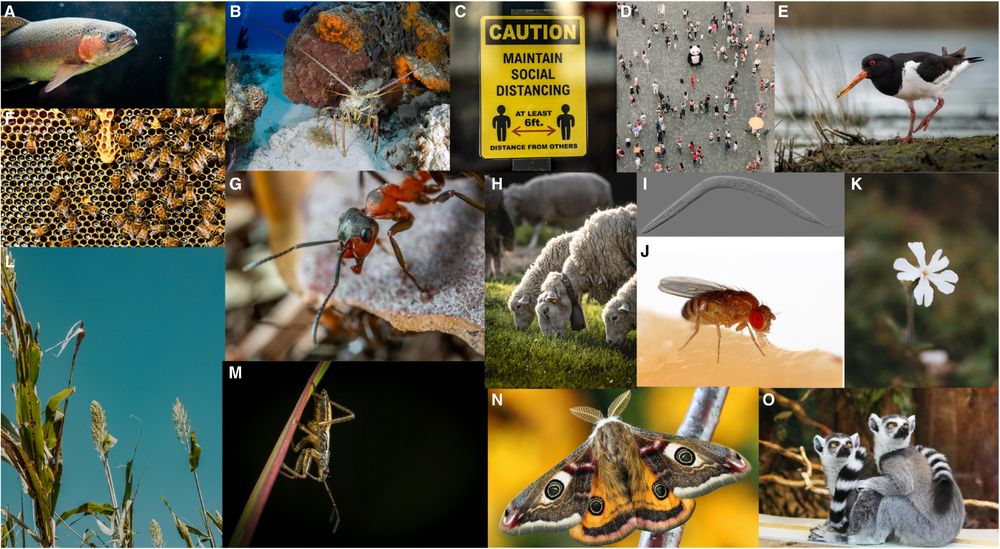
This figure highlights the diversity of avoidance across different species in response to pathogens and parasites. (A) Rainbow trout avoid waters with high concentrations of trematode cercariae, reducing exposure to these parasites. (B) Healthy Caribbean spiny lobsters avoid sharing dens with those infected by viruses, preventing the spread of infection within their communities. (C,D) Avoidance underlies many human public health measures such as social distancing, to minimize the risk of infectious disease contagion. (E) Oystercatchers avoid eating the largest cockles, which are likely to be infested with parasitic helminths. (F,G) Bees and ants (eusocial insects) exhibit complex social behaviours to minimize infection risks. Bees isolate or remove infected individuals from the colony, while ants restructure their social networks to reduce contact with fungal-infected foragers. (H) Sheep avoid food and water sources contaminated with feces, reducing the risk of ingesting parasites that may be present in such environments. (I,J) Caenorhabditis elegans and Drosophila melanogaster. These model organisms illustrate how detected pathogenic cues can modify behaviour and provide insights into the neurological integration of sensory perception and behavioural response to pathogens. Plants, like Saline latifolia (K), can avoid infection too, for example by flowering for shorter periods to reduce contact with fungal spores transmitted by pollinators. Root compounds of some sorghum (L) lines are associated with reduced germination of parasitic Striga seeds, demonstrating chemical avoidance strategies. (M) Crickets avoid detection by parasitic flies through the selection of variants that cannot sing, disrupting the ability of parasites to locate hosts acoustically. (N) Spongy moths show variability in larval behaviour to avoid virus-contaminated foliage. (O) Lemurs avoid water sources that have an elevated risk of fecal contamination.
This primer on infection avoidance was incredibly fun to write with @cr-amo.bsky.social and Mandy Gibson. We cover its taxonomic breadth, mechanisms and evolution, and its importance across fields as diverse as public health, conservation, and agriculture. 🧪
www.cell.com/current-biol...
#SymbioSky
20.05.2025 09:18 — 👍 11 🔁 8 💬 2 📌 0

STICKLEBACK 2025: 11th International Congress on Stickleback Behaviour and Evolution
Fourwaves - STICKLEBACK 2025: 11th International Congress on Stickleback Behaviour and Evolution
The upcoming International Stickleback Conference (at Bamfield Marine Science Center in late July) still has some openings, but register soon! Stickleback-curious researchers are welcome too!
event.fourwaves.com/stickleback-...
18.05.2025 23:56 — 👍 7 🔁 4 💬 2 📌 1
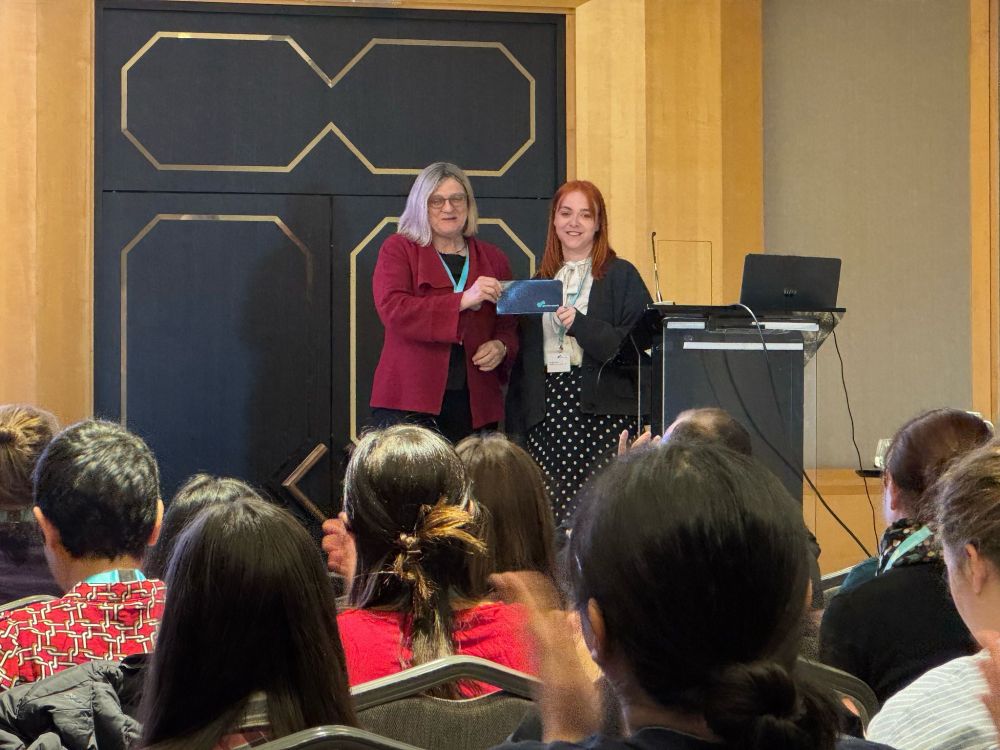
🎉 Congratulations @janayf.bsky.social on winning our 2025 Bruce Cattanach Prize!
Janay's talk is on the epigenetic plasticity in response to environmental stress: insights from an evolutionary fish model #Epigenetics2025
24.04.2025 15:50 — 👍 7 🔁 2 💬 0 📌 1

Check out our latest paper on phenotypic variation in guppies - led by Alexis Heckley.
"Abiotic environmental factors contribute to spatial variation in boldness and exploration in guppies (Poecilia reticulata)"
onlinelibrary.wiley.com/journal/1095...
17.04.2025 03:25 — 👍 2 🔁 2 💬 0 📌 0
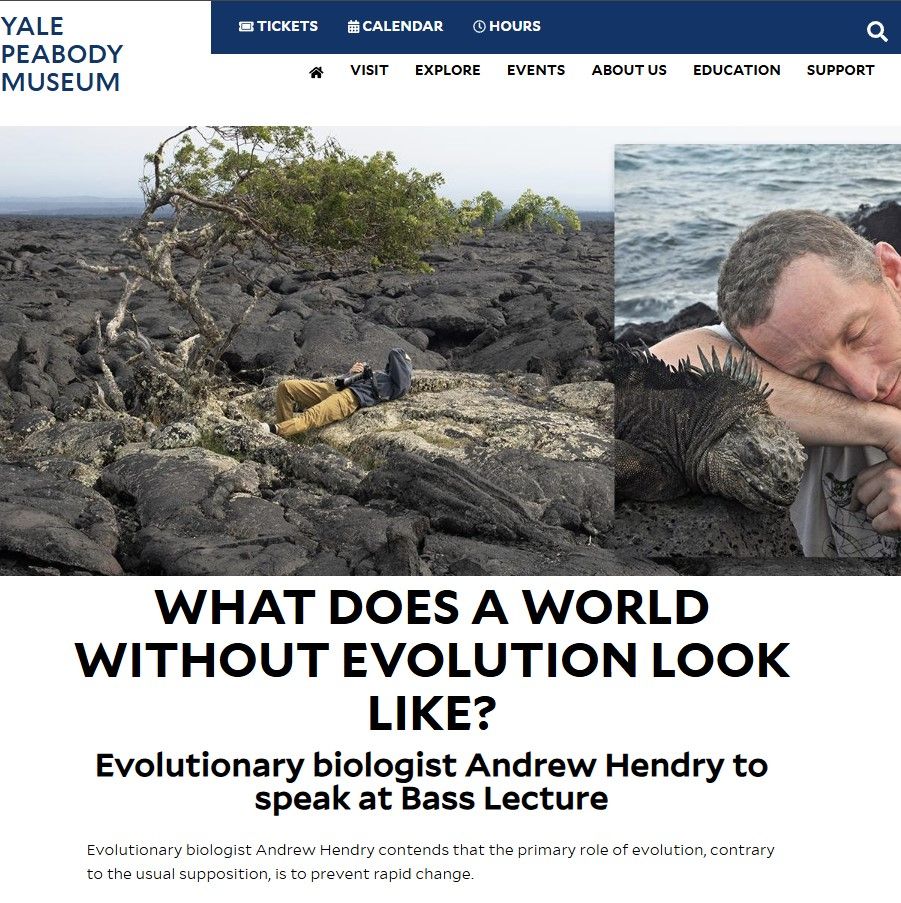
Live near New Haven, CT, and looking for something interesting to do April 23?
I am giving the Bass Distinguished Lecture, titled “The World Without Evolution?” taking place Wednesday, April 23 at 5 pm in O.C. Marsh Hall. The event is free and open to the public.
peabody.yale.edu/news/hendry_...
30.03.2025 17:17 — 👍 12 🔁 6 💬 0 📌 0
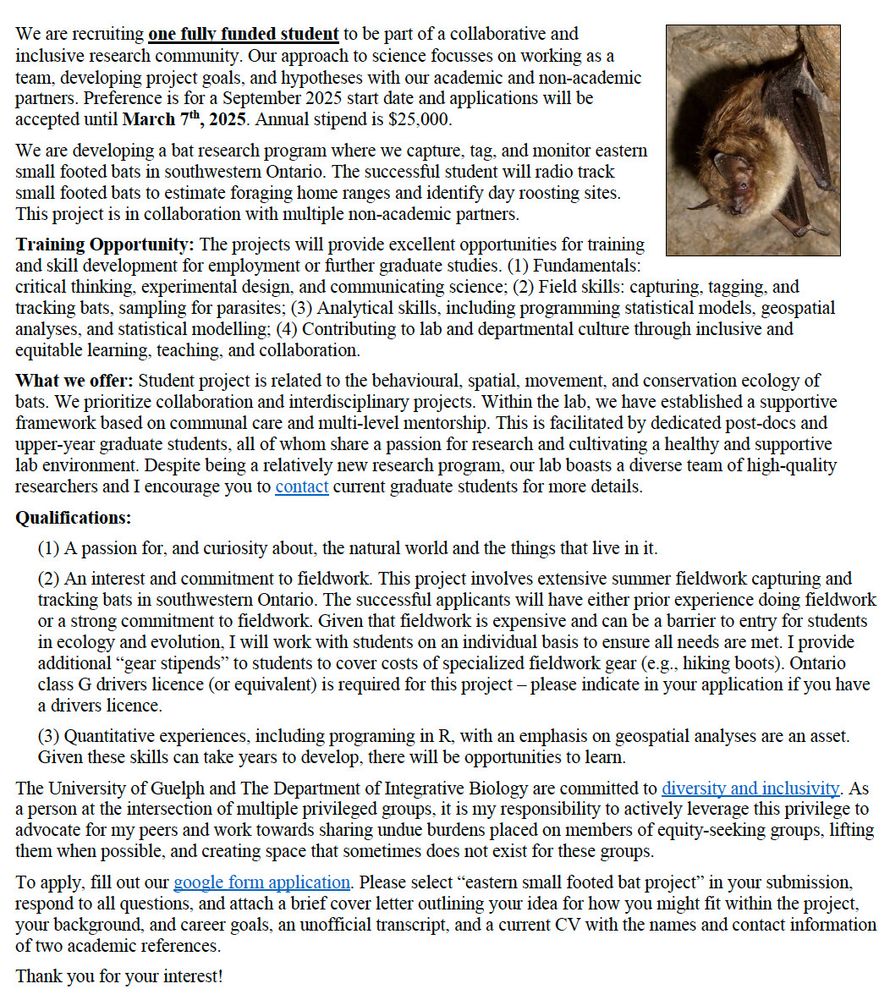
NEW MSc POSITION! We're starting a new study system on eastern small footed bats in Ontario. Please share widely and/or apply if you're interested in foraging ecology, bats, and conservation! Link to application is here: docs.google.com/forms/d/e/1F...
11.02.2025 16:42 — 👍 23 🔁 33 💬 0 📌 4
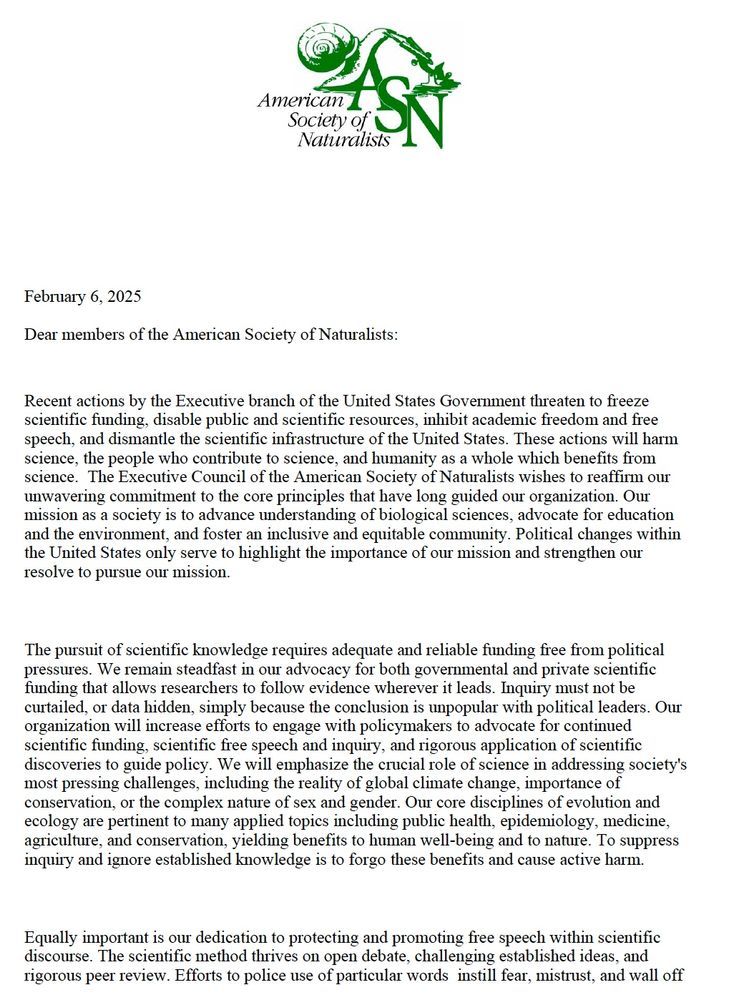
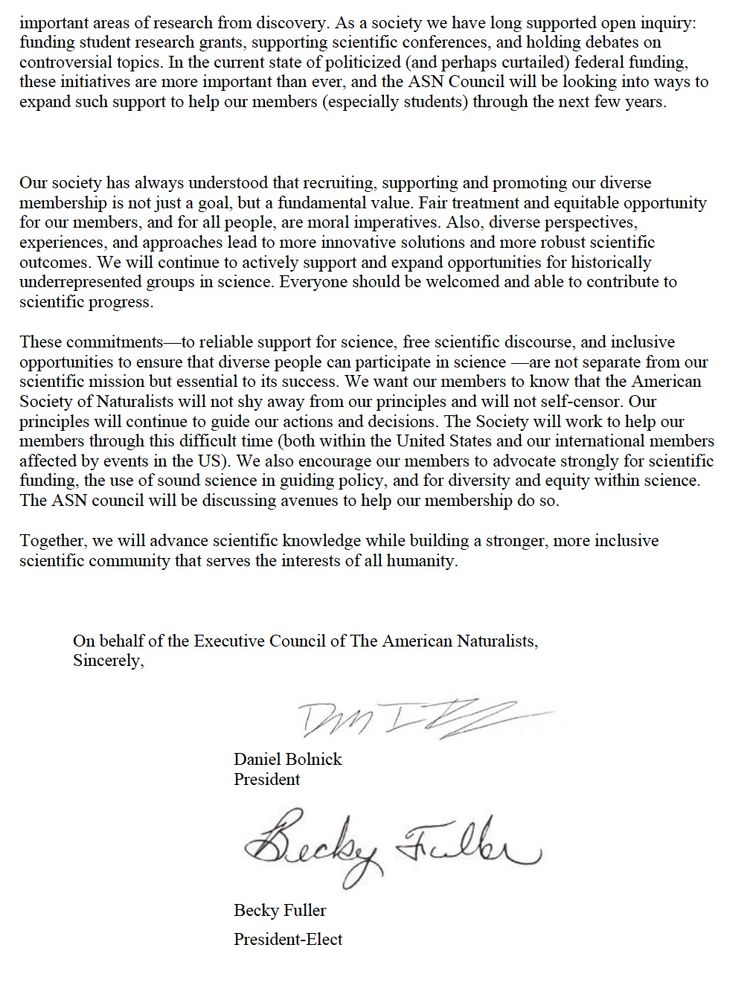
I usually reserve this account for my personal views; but today I want to represent my position as President of @asn-amnat.bsky.social to post a message that will shortly go out to the membership of the American Society of Naturalists from the ASN Executive Council
06.02.2025 16:28 — 👍 796 🔁 315 💬 35 📌 58

Here's a photo of my favorite grass host, Dactylis glomerata, infected with ergot and stem rust in the beautiful Swiss Alps
Please spread the word - I am looking for a postdoc to join my lab at @osubpp.bsky.social to study diversity and interactions of plants and pathogens in wild and working landscapes!
More information here: agsci-labs.oregonstate.edu/diseaseecolo...
04.02.2025 00:55 — 👍 32 🔁 23 💬 0 📌 7
Diverse hosts, diverse immune systems: evolutionary variation in bat immunology
bats are immunologically "special", but bat species also differ in their immune response. we gather evidence for interspecific variation in bat immunity, propose hypotheses, and outline future comparative directions. i've really enjoyed working with this ECR team.
ecoevorxiv.org/repository/v...
03.02.2025 17:28 — 👍 46 🔁 12 💬 2 📌 1
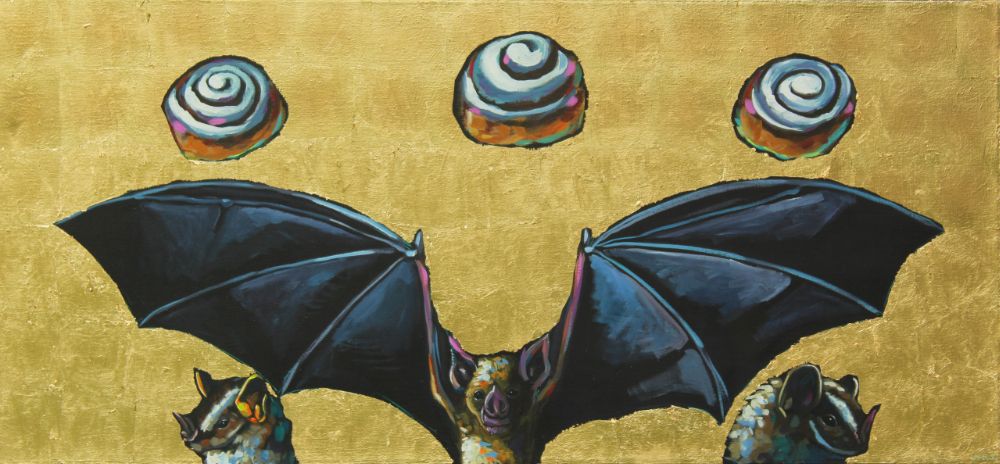
Will Eskridge original painting of three bats and three cinnamon rolls on gold leaf background. We Sold Our Souls For Cinnamon Rolls. acrylic and gold leaf on stretched linen
Well, I mean come on? #sweet prompt for #JanuArty ? I mean what's next #bats 🦇 ? Hahahahaha! Here ya go! Love you BlueSky -Happy Friday!
We Sold Our Souls For Cinnamon Rolls
33×72"
#bat #batart #bskyart #painting #art #artwork #wallart #fineart #ArtYear #wildlife #nature #weirdart #cinnamonroll
24.01.2025 14:12 — 👍 85 🔁 19 💬 2 📌 4
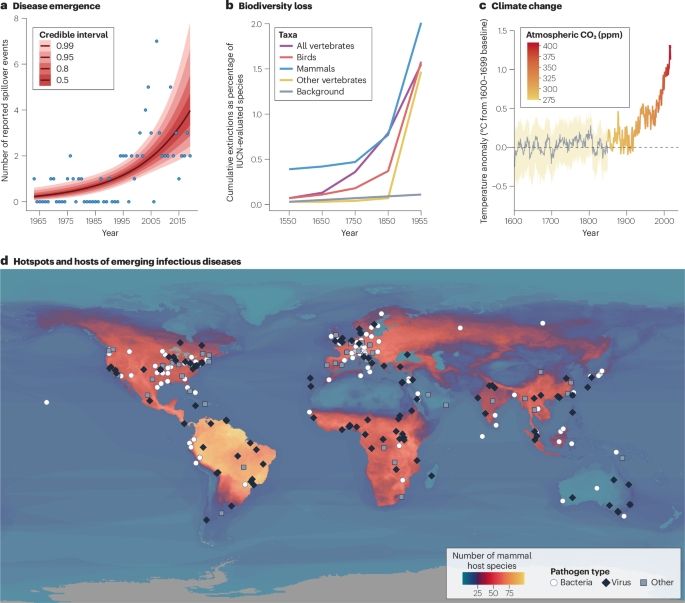
Pathogens and planetary change - Nature Reviews Biodiversity
This Review explores the relationship between emerging infectious diseases and biodiversity loss, and how both are connected to global environmental changes in the Anthropocene.
Quote: "Ecological and evolutionary principles help to explain why both pandemics and wildlife die-offs are becoming more common; [and] why land-use change and biodiversity loss are often followed by an increase in zoonotic and vector-borne diseases."
www.nature.com/articles/s44...
24.01.2025 03:14 — 👍 37 🔁 19 💬 1 📌 1
Jasper experienced a devastating wild fire. Now they need temporary housing - what’s the hold up? The UCP.
They won’t allow temporary housing unless it is permanent, and only single detached homes, and they have to be sold….
So temporary not temporary housing.
#AbLeg
23.01.2025 15:23 — 👍 83 🔁 28 💬 2 📌 0
Weather and landscape morphology drive thermal regime variation among Mývatn ponds, and implications for resident Arctic charr
If you need a distraction and find reading science about weird ponds relaxing, I have a new preprint up with Joe Phillips, Bjarni Kristjánsson, and Camille Leblanc about some cave pond limnology. doi.org/10.32942/X2G... 💧🐟
21.01.2025 23:05 — 👍 2 🔁 2 💬 1 📌 1
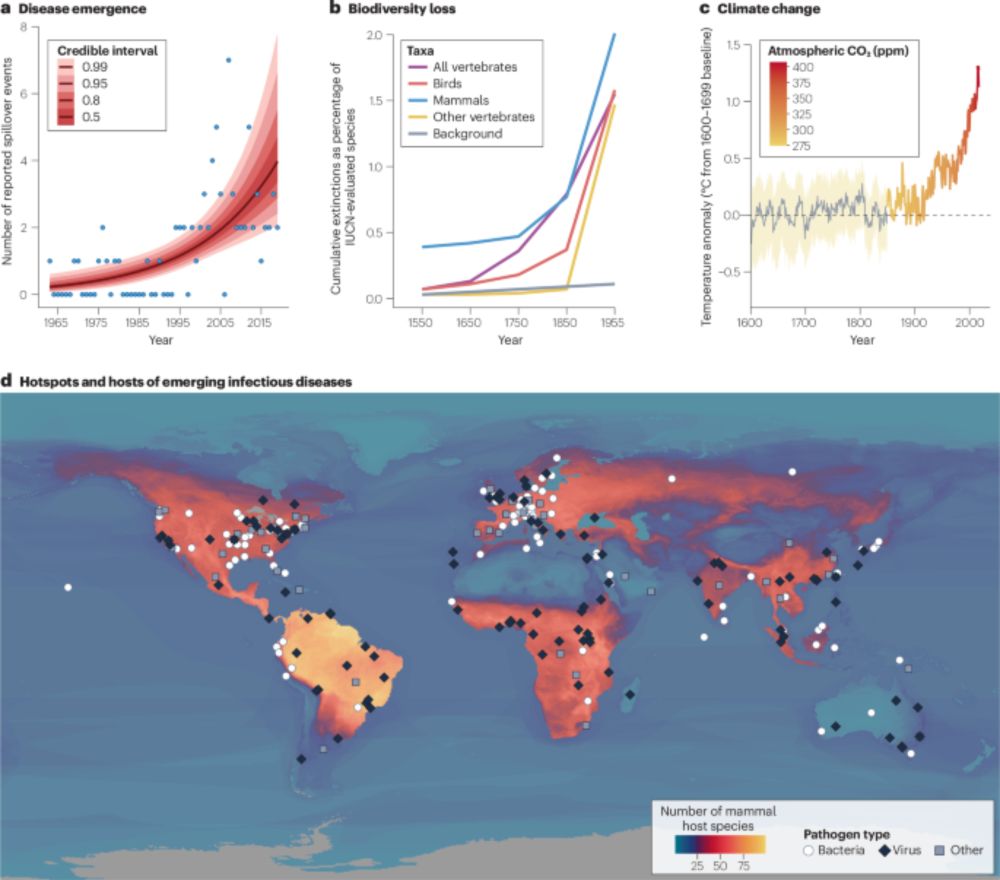
Pathogens and planetary change - Nature Reviews Biodiversity
This Review explores the relationship between emerging infectious diseases and biodiversity loss, and how both are connected to global environmental changes in the Anthropocene.
There's a lot of replies to our new paper talking about how capitalism or overpopulation are the real enemy. Without getting into whether that's true of the climate emergency or the sixth mass extinction (🙃), I want to briefly explain why pandemics are different. www.nature.com/articles/s44...
16.01.2025 18:15 — 👍 54 🔁 29 💬 2 📌 4
Check out our new review, 'Pathogens and Planetary Change', in @natrevbiodiv.bsky.social! The paper is nicely summarized in this thread by @ctrlalttim.bsky.social (and another thread I've also re-posted by @colincarlson.bsky.social). Very excited to have been part of this fantastic collaboration!
16.01.2025 17:09 — 👍 4 🔁 1 💬 0 📌 1
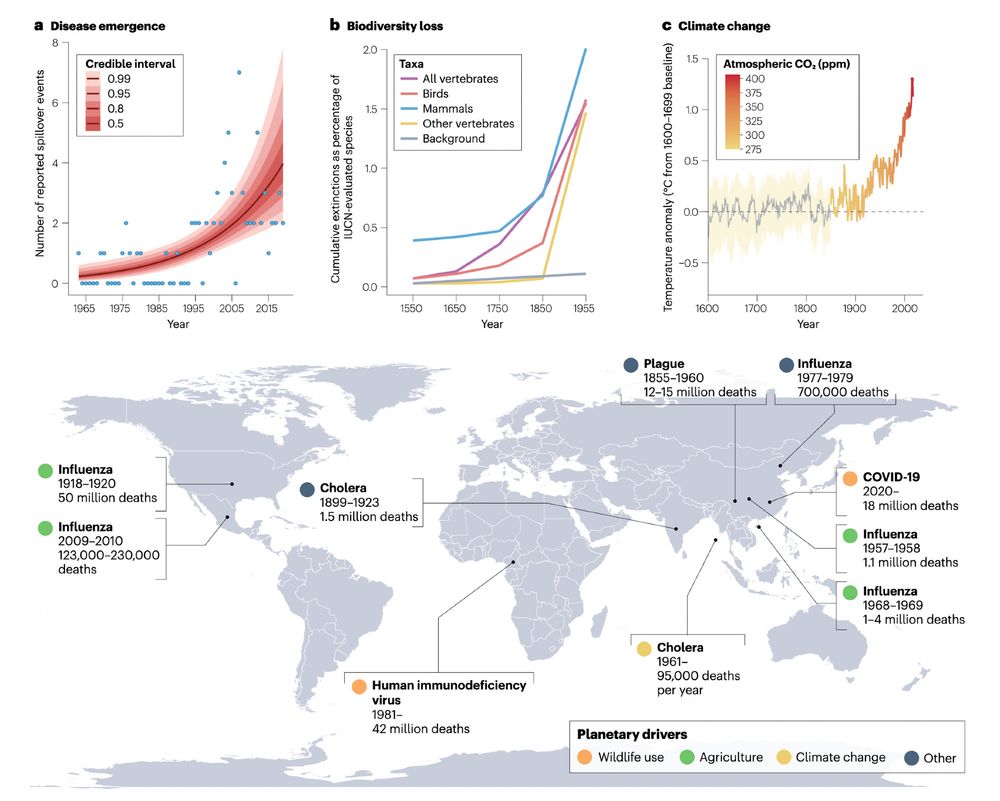
🦠 NEW REVIEW 🌡️ What does health have to do with environmental change? Well, a lot, but the way that pop-sci describes these relationships isn't always the case: www.nature.com/articles/s44.... So, what does it all mean? We try to answer this in our new review "Pathogens and planetary change" 🧵
16.01.2025 16:41 — 👍 26 🔁 10 💬 1 📌 1
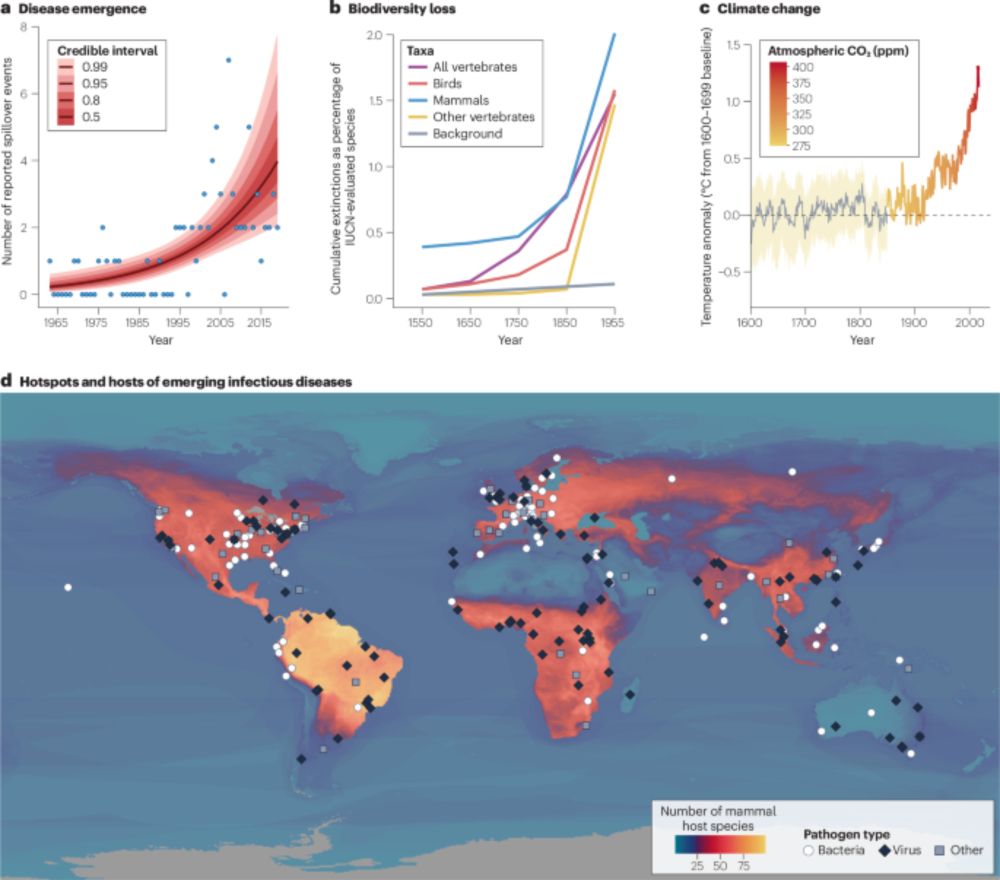
Pathogens and planetary change - Nature Reviews Biodiversity
This Review explores the relationship between emerging infectious diseases and biodiversity loss, and how both are connected to global environmental changes in the Anthropocene.
Couldn't ask for a better first Bluesky post! Our new paper, "Pathogens and planetary change," is out now in @natrevbiodiv.bsky.social. We discuss the linkages between biodiversity loss + pandemics and how we can address these interconnected crises 🧪😷
Give it a read: www.nature.com/articles/s44...
16.01.2025 01:41 — 👍 84 🔁 29 💬 1 📌 2
🚨New paper out @natrevbiodiv.bsky.social on how pathogens and parasites are responding to global change, and implications for pandemic prevention and biodiversity conservation. Check it out below!
15.01.2025 20:08 — 👍 11 🔁 5 💬 0 📌 0
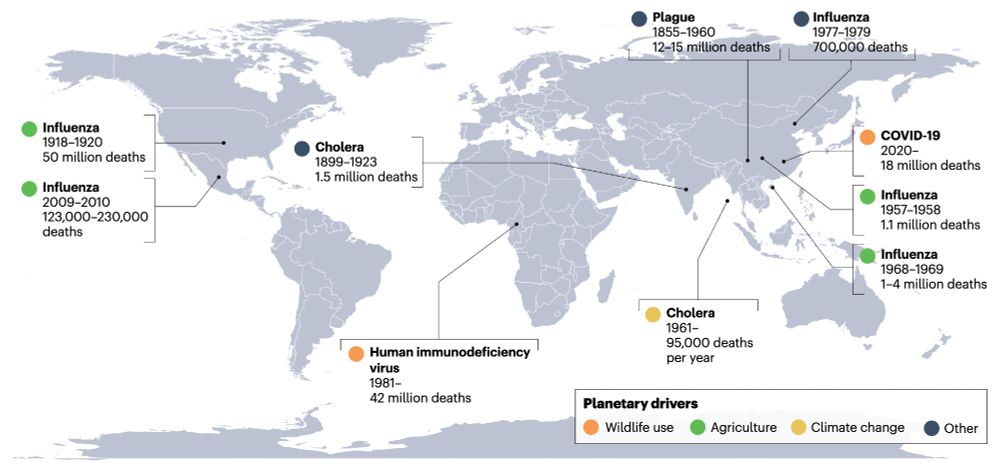
A map of 10 pandemic since 1900. Four (all influenza) were related to agriculture; two (HIV and Covid-19) were related to wildlife use; one (cholera) was related to climate change; and three (cholera, plague, and influenza) were not related to any planetary change drivers.
Popular science narratives about pandemics - specifically, that they happen because of disordered relationships with nature - just aren't true. Half of modern pandemics have been one virus (influenza), and only a modest fraction of pandemic pathogens (3 of 10) have jumped from wildlife to humans.
15.01.2025 14:30 — 👍 26 🔁 7 💬 2 📌 0
🧪😷 Biodiversity loss and disease emergence share common drivers - meaning that there are opportunities to create shared solutions for biodiversity and health. Global and national governance efforts to combat disease events must be integrated with environmental protection and sustainable development
15.01.2025 16:00 — 👍 18 🔁 13 💬 1 📌 1
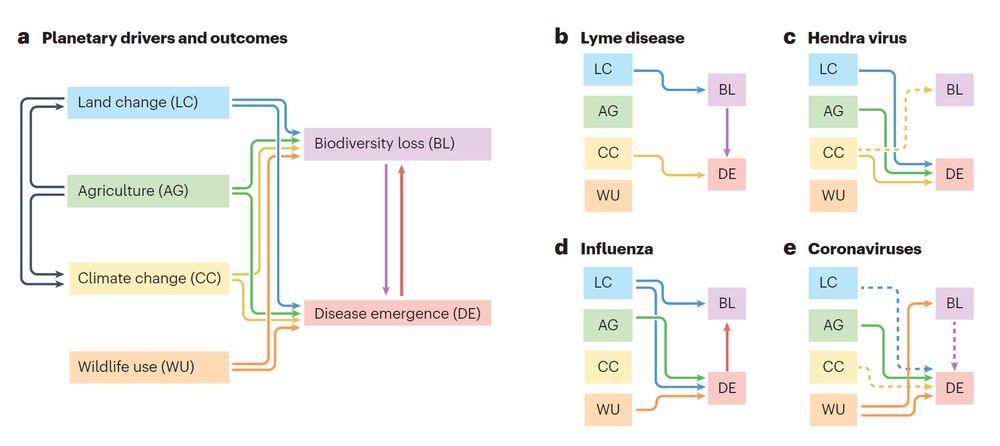
Biodiversity loss can drive disease emergence, and vice versa; they also share many of the same upstream drivers.
Carlson and colleagues explore the relationships between emerging infectious diseases, biodiversity loss, and global environmental change. go.nature.com/4gT0za1
15.01.2025 15:22 — 👍 26 🔁 16 💬 1 📌 0
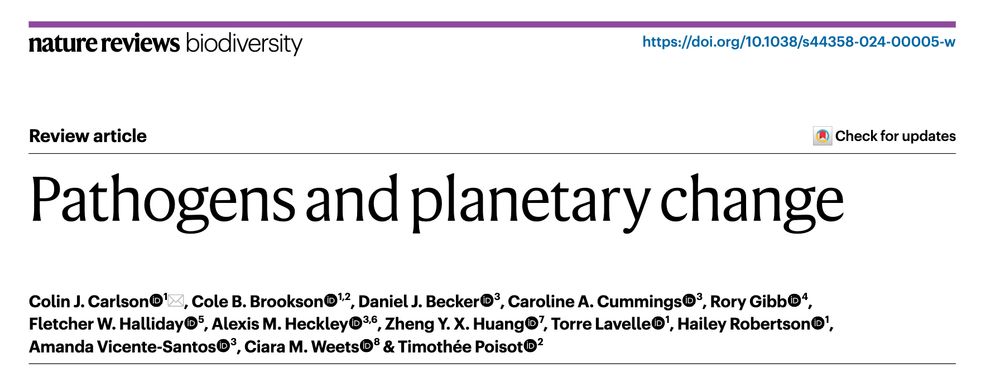
header of our paper "Pathogens and planetary change"
If you take one thing away from our paper, I hope it's this: there's no safe path through the Pandemicene without action on environmental protection, sustainable development, and health system strengthening. Single-issue advocacy and siloed solutions put the world at greater risk from pandemics.
15.01.2025 14:42 — 👍 57 🔁 23 💬 2 📌 3
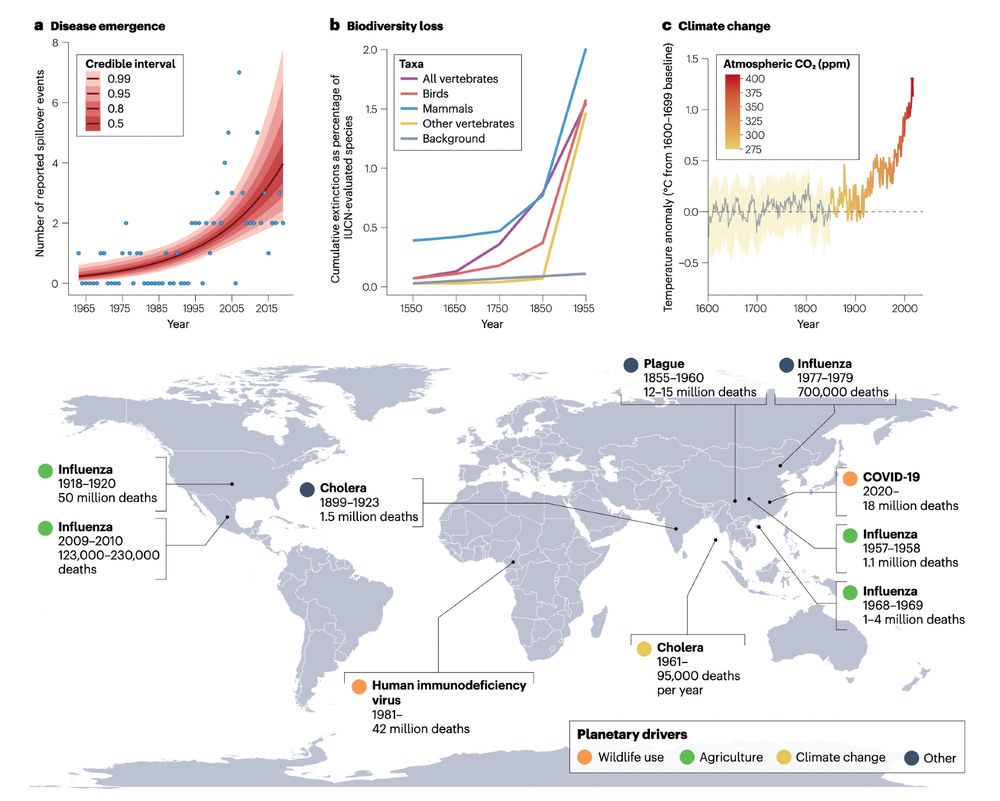
Top panels: graphs showing increases in spillover events, extinction rates, and temperature anomalies over the last few centuries. Bottom panel: a map of 10 pandemics since the year 1900. Four were linked to agriculture, two to wildlife use, and one to climate change.
🚨😷🧪 NEW: A growing body of evidence shows that pandemics, biodiversity loss, and climate change are part of a broader polycrisis - but there are no simple solutions. A sweeping overview of "Pathogens and planetary change" for the first issue of @natrevbiodiv.bsky.social, out now 🔓 rdcu.be/d6lHl
15.01.2025 14:16 — 👍 542 🔁 227 💬 17 📌 19
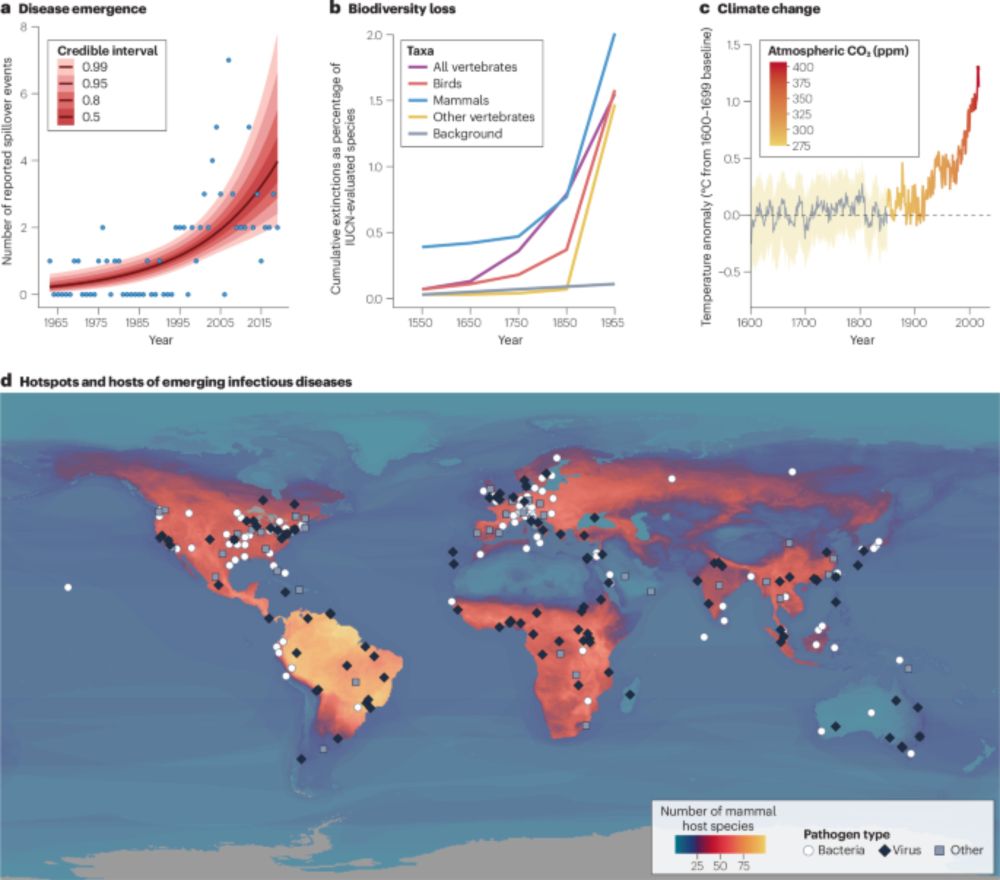
Pathogens and planetary change - Nature Reviews Biodiversity
This Review explores the relationship between emerging infectious diseases and biodiversity loss, and how both are connected to global environmental changes in the Anthropocene.
How are pathogens and parasites responding to planetary change, what does this mean for people and biodiversity, and what is to be done? New @viralemergence.org synthesis out today in Nature Rev Biodiversity (@natrevbiodiv.bsky.social) with a fantastic author team🧪😷
www.nature.com/articles/s44...
15.01.2025 14:18 — 👍 86 🔁 47 💬 1 📌 1
Francis Dinh also contributed to this work but I don't think Francis is on bluesky!
12.12.2024 16:09 — 👍 0 🔁 0 💬 0 📌 0
HFSP Postdoctoral Fellow @ University of Oklahoma | wildlife disease ecology | ecoimmunology | zoonotic pathogens of bats and rodents | love biodiversity and natural history | newbie to bluesky
Postdoc in elephant behavioural ecology at The University of Hong Kong 🐘 🌱 🏳️🌈
Behavioural and evolutionary ecologist, lecturer in Bangor, Wales - sociality, stress, mostly in reptiles macleodlab.weebly.com
SOS is a grassroots organization advocating for better grad student and postdoc pay for ALL researchers in Canada through increased investments www.supportourscience.ca
The social media you want. Built for Canada.
Fun, private, and ethical. We're changing the way social media is done around here, all without your data taking an unexpected trip south. Built on Bluesky.
https://gandersocial.ca
President of Signal, Chief Advisor to AI Now Institute
#wildlife scientist; adjunct @mripas.bsky.social in #BiałowieżaForest; keen on #transboundary #mammals, #forests, #OneHealth, #RightsOfNature, knowledge-sharing, peace-building, walking; former asylee; east of the west. Donate: https://www.pcrf.net/donate
Professor of Evolutionary Biology at Anglia Ruskin University, Cambridge.
www.thepeergroup.org.uk
PEER Group research is focused on primate evolution and ecology, with a particular emphasis on vocal communication and the evolution of language.
"It’s Political" podcast host/producer, National columnist for the Toronto Star,
"At Issue" panellist on CBC’s The National.
Scientist and software developer. Creator of tidyplots.org. Website jbengler.de.
Behavioural & evolutionary ecologist
Prof @uqam, Montreal.
Livre : Le dilemme de la gazelle @HumenSciences;
Chronique : Moteur de Recherche @iciradiocanada.bsky.social
#personality, #behaviour, #life_history, #phenotypic_plasticity, #quantitative_genetics
With nature, we build a thriving world. #NatureMakesItPossible | Avec la nature, nous créons un monde prospère. #AvecLaNatureCestPossible
natureconservancy.ca
Behavioural ecologist, scientist, assoc/prof at University of Helsinki - how does ecology of information-use shape evolution?
raised in NZ, grew up in UK, now in Finland
❗ Official Bluesky account of the Czech and Slovak Ethological Society. ❗ We spread news about ethological research conducted not only by our members. 🐎🐦🐒
Behavior, Evolution, Endocrinology, and Birds. Associate Professor at OWU, a PUI/SLAC. Research with undergraduates!
We work on planetary problems. Currently: counting climate change-related deaths; pandemic risk assessment in a changing biosphere; data, science, and vaccine access during public health emergencies. 👉 carlsonlab.bio
#UAlberta political scientist | Black Faculty Collective | Lead: Common Ground (@cgroundpolitics.bsky.social) | jaredwesley.ca | drjaredwesley.substack.com | co-author: partyloyalty.ca
Podcaster - The Bridge, Host - SiriusXM, Author 4 best sellers, Filmmaker, Distinguished Fellow, U of T, Chancellor Emeritus MTA.ca, Senior Counsel Spark *Advocacy and HCol CANSOFCOM



